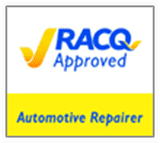Brake and clutch repairs
As the most important safety system on your vehicle, we take brakes very seriously.
All modern cars utilise disc brakes, usually on both the front and rear of the vehicle. Most utes and some smaller cars will use disc brakes on the front and drum brakes on the rear. Both styles still rely on the same principle – using a friction material (brake pads or shoes) pushing against a rotating mass (disc rotors or drums), converting rotating energy into heat which ultimately slows the vehicle down. All this heat and friction means your brakes are one of the toughest environments on the car. We insist on using nothing but the best parts and techniques to ensure your brake repair is as safe and effective as possible. We use and recommend Bendix brake pads and shoes.
Due to friction, as the brake pads or shoes are used they wear away and eventually need replacing This is the most common brake repair required.
The brake disc rotors or drums also wear away, though usually at a slower rate, and will eventually require replacement also. When replacing the pads or shoes, we measure the rotors or drums down to decimals of millimetres, to ensure there is enough material remaining to safely reuse the part – if there is any chance that the rotors or drums will fall outside of the manufacturer specified measurements, they must be replaced. This is a matter of safety. A disc rotor that goes below its minimum thickness cannot dissipate heat correctly and can cause your brakes to fail completely.
Fitting brake pads or shoes to old rotors or drums is the most common cause of brake squeal or brake shudder – where vibrations are felt every time you use the brakes. This is due to the buildup of the old friction material that is left on the old rotor or drum, causing microscopic peaks and valleys. To ensure your brake repair is as good as a brand new vehicle, when fitting new pads or shoes (and if the rotors or drums are within measurements), we use our onsite brake lathe to machine the rotors or drums to remove all left over material and undulations. This cuts an extremely precise, brand new surface onto the rotor or drum, making it as good as new – without the additional cost of buying new rotors or drums.
Further to this we complete our professional brake repair by cleaning the disc brake caliper and applying high temperature lubricant to all moving surfaces This ensures trouble free braking for the life of your new brake pads.
Although brake pads or shoes are by far the most common repair, we can take care of all aspects of the braking system, including the hydraulic system, such as brake master cylinder repairs or overhauling brake calipers, through to electronic diagnosis of Anti Lock Braking (ABS) systems.
CLUTCH
At Steve Sorensen Mechanical we have everything from the delicate self-adjusting clutch setup rigs through to heavy duty 4WD gearbox jacks to ensure your clutch replacement is completed per manufacturer specifications – efficiently and safely.
The clutch transfers the engines power through to the gearbox, which ultimately leads to driving your wheels.
We expect regular single plate clutch systems to usually last approximately 160,000km before requiring replacement, although this is hugely impacted by various factors such as driving style, oil leaks and towing.
Like many vehicle systems, the humble clutch has undergone many changes in recent years in the name of efficiency and user friendliness. This has meant the introduction of several different clutch actuation and engagement systems – most notably Dual Mass Flywheels.
This ultimately means that a clutch replacement that was previously possible for the backyard enthusiast, now requires several manufacturer specific tools. Using these specific tools will ensure your new clutch gives smooth and direct operation that matches or exceeds your original clutch life.
Please don’t hesitate to contact us on (07) 3809 2711 for all of your Brake And Clutch Repairs needs.





